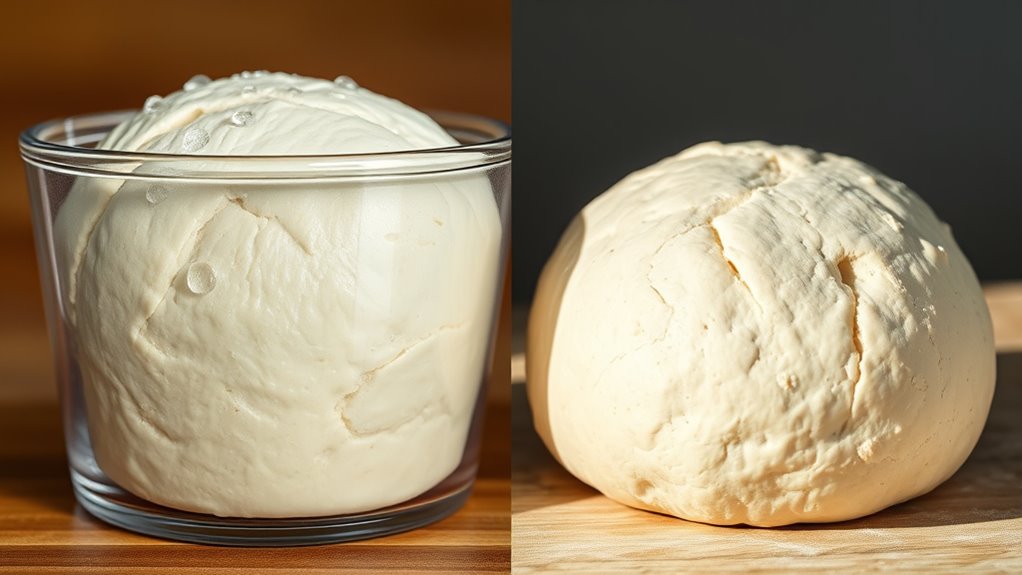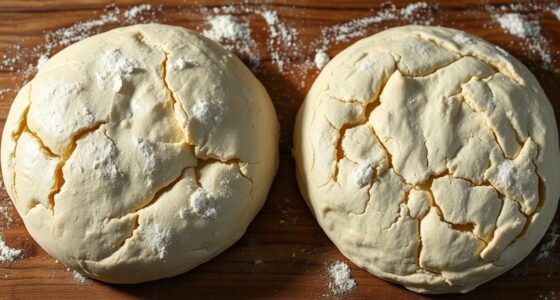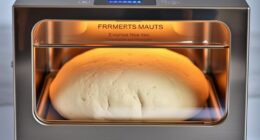In choosing between cold fermentation and room temperature, understand that cold slows yeast activity, allowing complex flavors to develop and making dough easier to handle, while room temp speeds up fermentation for quicker results. Temperature affects gluten development, flavor depth, and dough strength. Proper timing, equipment, and environment are key. If you keep these principles in mind, you’ll open the full potential of each method—stick around to learn the 10 essential rules that will transform your baking experience.
Key Takeaways
- Cold fermentation develops complex flavors slowly, while room temp speeds up fermentation but risks overproofing.
- Cooler temps strengthen gluten networks, improving dough elasticity and handling compared to the softer structure from room temp.
- Cold fermentation offers greater control over timing, making it ideal for flavor layering and scheduling flexibility.
- Room temperature fermentation accelerates yeast activity, requiring careful monitoring to prevent overproofing and gluten breakdown.
- Combining cold and room temp methods enhances flavor, texture, and oven spring, leveraging benefits of both approaches.
Understanding the Basic Differences Between Cold and Room Temperature Fermentation
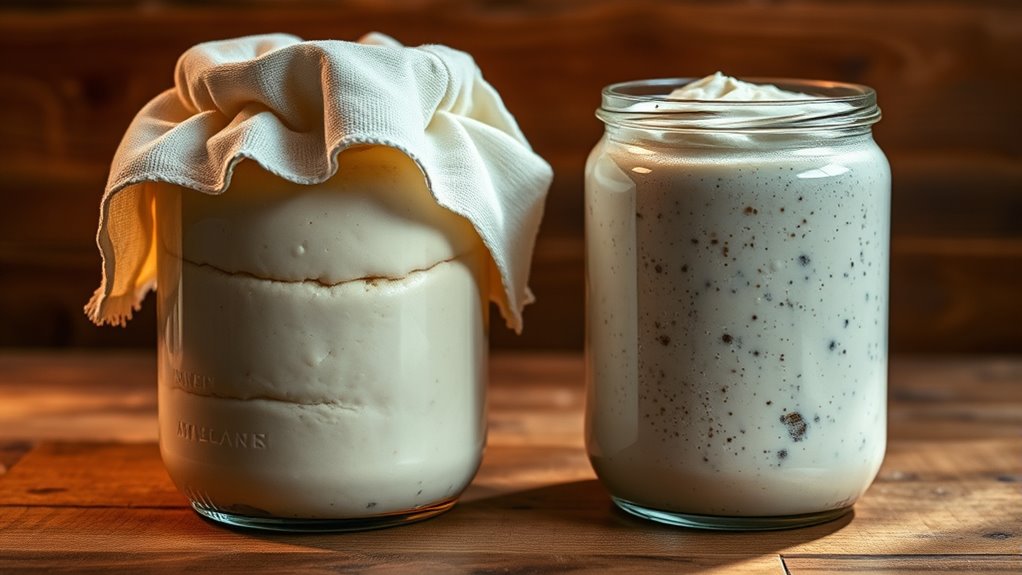
Understanding the basic differences between cold and room temperature fermentation is essential for mastering bread-making. When fermenting at room temperature, yeast remains active, promoting quicker fermentation, which can impact yeast health if overdone. Cold fermentation slows yeast activity, allowing flavors to develop more deeply without stressing the yeast or compromising gluten strength. This slower process helps maintain a balanced gluten structure, resulting in a better rise and texture. In contrast, room temp fermentation requires careful timing to prevent overproofing and yeast fatigue. Knowing these differences enables you to control fermentation better, ensuring yeast health stays ideal and gluten develops properly. Additionally, utilizing appropriate fermentation techniques can optimize flavor and texture outcomes. Whether you choose cold or room temperature, understanding these fundamental variations helps you produce consistently delicious bread.
How Temperature Affects Yeast Activity and Gluten Development
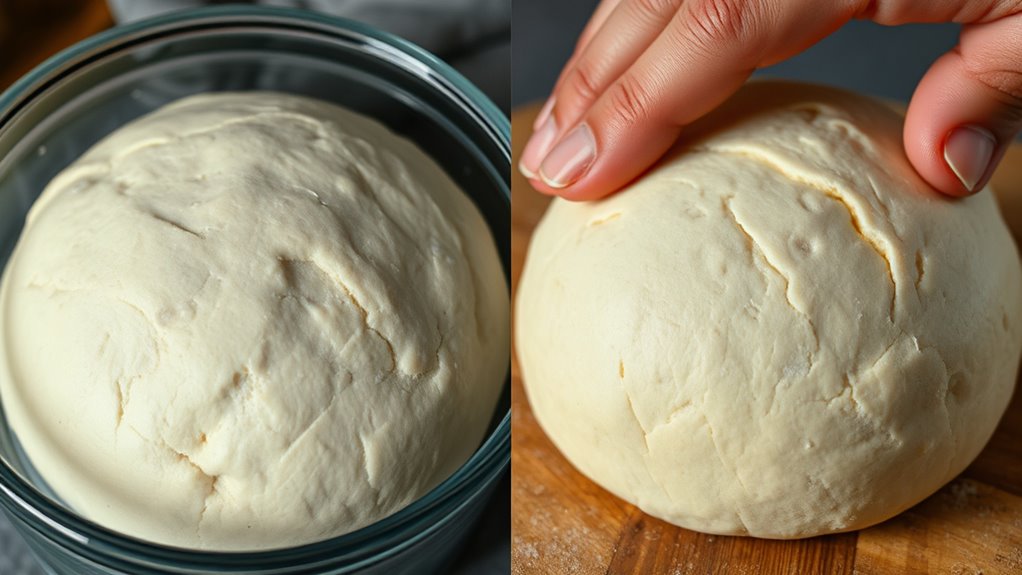
Temperature directly influences how quickly yeast ferments and how gluten forms in your dough. Warmer conditions speed up yeast activity but can weaken gluten structure, while cooler temps slow fermentation and develop stronger gluten. Understanding these effects helps you control the texture and rise of your baked goods. Implementing vertical storage solutions can also help maintain consistent temperature zones for better fermentation control.
Yeast Fermentation Rates
Yeast activity is highly sensitive to temperature changes, which directly impacts fermentation rates and gluten development. As temperature rises, yeast activity accelerates, producing more CO₂ and speeding fermentation. Conversely, cooler temps slow yeast growth, resulting in a longer process. This variation influences gluten structure, making it more extensible at different rates. To visualize, consider this table:
| Temperature Range | Yeast Activity | Gluten Development |
|---|---|---|
| Cold (40-50°F) | Slow | Gentle, less elastic |
| Room Temp (70-75°F) | Moderate | Well-developed |
| Warm (80-90°F) | Fast | Potentially overdeveloped |
Understanding these rates helps you control fermentation, ensuring the gluten structure forms just right without overproofing or underproofing. Temperature truly guides yeast’s role in shaping your dough. For optimal results, monitoring fermentation temperature can prevent issues like overproofing or underproofing, leading to a better baked product.
Gluten Formation Dynamics
As yeast activity fluctuates with temperature, it directly influences how gluten proteins bond and develop within your dough. Warmer temperatures speed up gluten network formation, increasing dough elasticity and making it easier to shape. Cooler temperatures slow down this process, resulting in a softer, less elastic dough but allowing for more complex gluten structures over time. At room temperature, gluten formation is rapid and straightforward, while cold fermenting fosters a gradual, more nuanced gluten network. This difference impacts the dough’s texture and strength. Puppy Socialization Higher temperatures promote quicker gluten cross-linking, improving dough stretchability. Cold environments delay gluten development, leading to a tender, less chewy texture. Temperature influences the alignment of gluten proteins, affecting dough elasticity. Consistent temperature control guarantees desired gluten network characteristics throughout fermentation.
The Impact of Cold Fermentation on Flavor and Texture
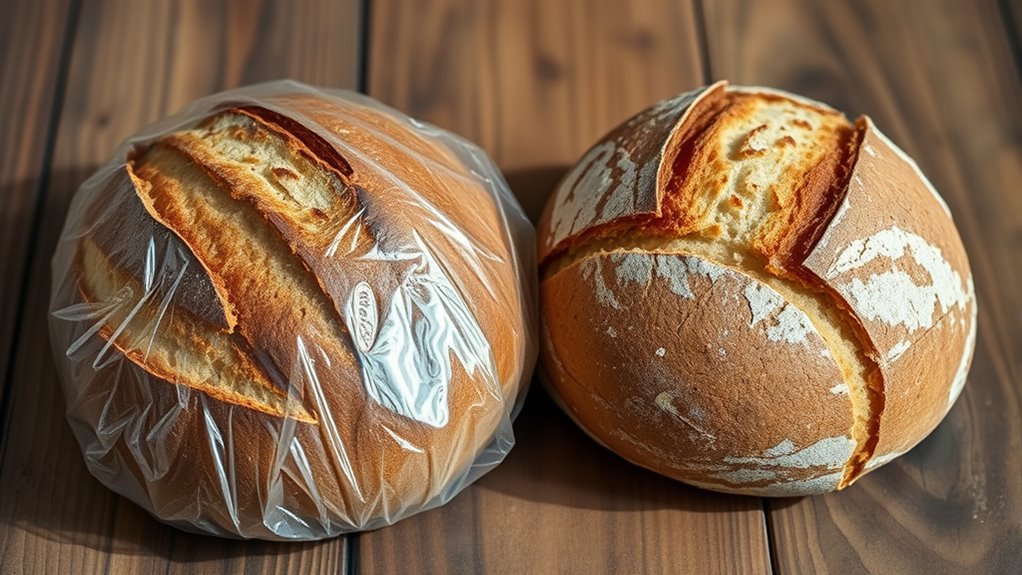
Cold fermentation enhances the flavor of your dough by allowing complex tastes to develop slowly. It also improves the dough’s texture, making it easier to handle and resulting in a better crumb. You’ll notice a richer, more refined final product when you choose cold fermentation. Additionally, it can help develop authentic farmhouse charm through subtle nuances in taste and appearance.
Enhanced Flavor Development
Because cold fermentation slows down the yeast activity, it allows the flavors to develop more fully and complexly over time. The extended fermentation gives the ingredients a chance to meld, resulting in a richer, more nuanced taste. During this process, gluten development continues gradually, improving dough structure without rushing. This slow fermentation enhances the depth of flavor by allowing natural fermentation byproducts, like organic acids and esters, to form more completely. You’ll notice a more rounded aroma and a subtle tang that’s absent in quick room temp ferments. Understanding fermentation reveals how slow processes can lead to more sophisticated flavor profiles.
Improved Dough Texture
Cold fermentation markedly enhances dough texture by allowing gluten strands to develop more gradually and thoroughly. This slow process improves dough elasticity, making it easier to shape and handle without tearing. Because yeast activity slows down in cold temperatures, the fermentation occurs gradually, giving gluten proteins time to form a stronger, more cohesive network. As a result, your dough becomes more resilient and less sticky. The extended fermentation also promotes even hydration, contributing to a smoother, more uniform crumb. You’ll notice a better balance between stretchiness and firmness, which helps achieve a chewy yet tender texture. In short, cold fermentation transforms your dough into a more elastic, well-structured base, giving you a superior final product with improved texture and handling properties. Additionally, hybrid techniques that combine cold fermentation with other methods can further optimize flavor and texture.
When to Use Cold Fermentation Versus Room Temp for Best Results

Choosing the right fermentation temperature depends on the desired flavor, texture, and timing of your baking process. Cold fermentation is ideal when you want complex flavors and more manageable dough handling, especially if you plan to extend fermentation. Use room temperature when you need quicker fermentation, such as tight schedules or immediate baking. Cold fermentations slow down fermentation timing, giving you more control over dough development. Conversely, room temp speeds up this process, saving time. Incorporating strong communication skills into your process can help in coordinating fermentation schedules and troubleshooting issues effectively.
Adjusting Fermentation Times Based on Temperature Conditions
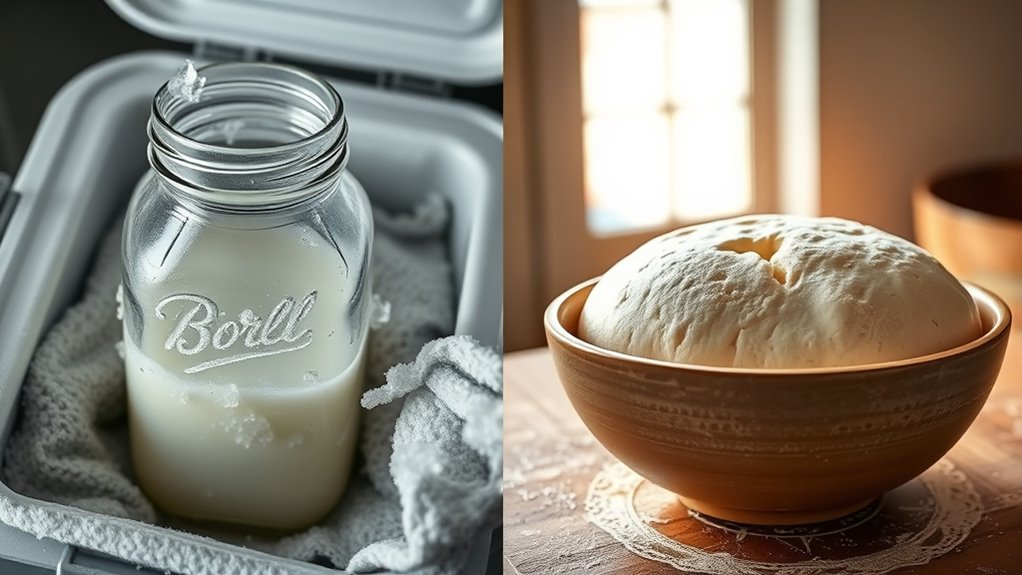
Adjusting fermentation times based on temperature conditions requires paying close attention to how heat or cold affects your dough’s activity. When it’s warmer, yeast vitality increases, speeding up fermentation and strengthening the gluten network. In colder conditions, yeast slows down, so you need to extend fermentation to develop flavor and structure properly. Use this table as a guide:
| Temperature Range | Adjusted Fermentation Time |
|---|---|
| Warm (75-85°F) | Shorten time, monitor dough closely |
| Cool (60-70°F) | Lengthen time, ensure proper rise |
| Cold (below 60°F) | Greatly extend, patience needed |
Additionally, understanding wicking materials can help optimize temperature regulation in your fermentation environment.
The Role of Temperature in Controlling Fermentation Speed and Consistency

Temperature plays a crucial role in determining how quickly and consistently your dough ferments. In fermentation science, precise temperature regulation is essential to control fermentation speed and achieve reliable results. Warmer temperatures accelerate yeast activity, making dough rise faster, but can compromise flavor and texture. Cooler temperatures slow fermentation, allowing flavors to develop more fully and improving consistency. Additionally, understanding the Relationships – Personality Test can help bakers interpret how environmental factors influence fermentation dynamics and outcomes.
To master fermentation, consider these factors:
- Ideal temperature ranges for different dough types
- How temperature fluctuations impact yeast activity
- The importance of steady temperature for uniform fermentation
- How temperature influences fermentation byproducts and flavor development
Common Mistakes to Avoid When Choosing Your Fermentation Method
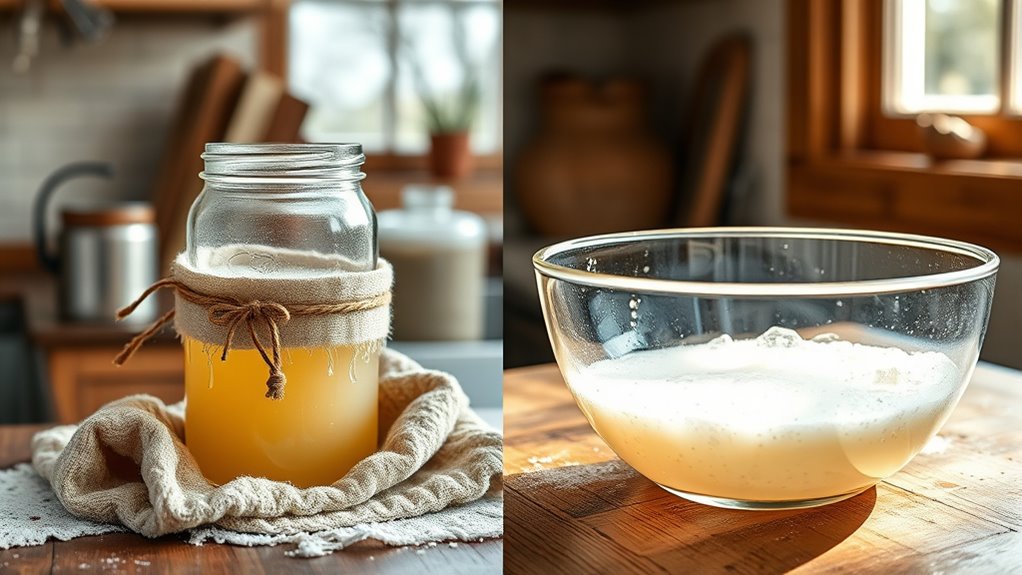
Many bakers overlook the importance of selecting the right fermentation method for their dough, which can lead to inconsistent results or compromised flavors. Common pitfalls include making incorrect assumptions about fermentation times or temperature effects, thinking cold fermentation always takes longer or that room temp is faster without considering dough type. Avoid rushing the process or trying to shortcut steps, as this can hinder gluten development and flavor development. Don’t assume one method suits all recipes; each dough responds differently. Mistakes also arise from not adjusting hydration or fermentation duration based on your environment. Recognizing these common pitfalls helps you make informed choices, ensuring your dough ferments properly and yields the best flavor and texture. Proper selection of fermentation method ultimately leads to more consistent, delicious bread.
Equipment and Environment Tips for Maintaining Optimal Temperatures

Choosing the right fermentation method is only part of achieving consistent results; maintaining the proper environment and equipment plays a vital role. To enhance your process, invest in tools that help regulate temperature and humidity. Using a fermentation chamber or a temperature-controlled space allows for better climate adaptation, reducing fluctuations that affect your dough. Keep a thermometer handy to monitor conditions consistently. Adjust ingredient quantities based on ambient temperature—warmer environments may require slight ingredient adjustments to prevent over-fermentation. Consider the following tips:
Maintain consistent fermentation by controlling temperature and humidity with chambers, thermometers, and climate-friendly equipment.
- Use insulated containers or blankets to stabilize temperature fluctuations
- Place your dough in a draft-free, climate-controlled area
- Incorporate a digital thermostat for precise climate control
- Regularly check and calibrate your equipment for accuracy
These steps help guarantee your dough ferments perfectly, regardless of external conditions.
How to Recognize When Your Dough Has Fermented Properly
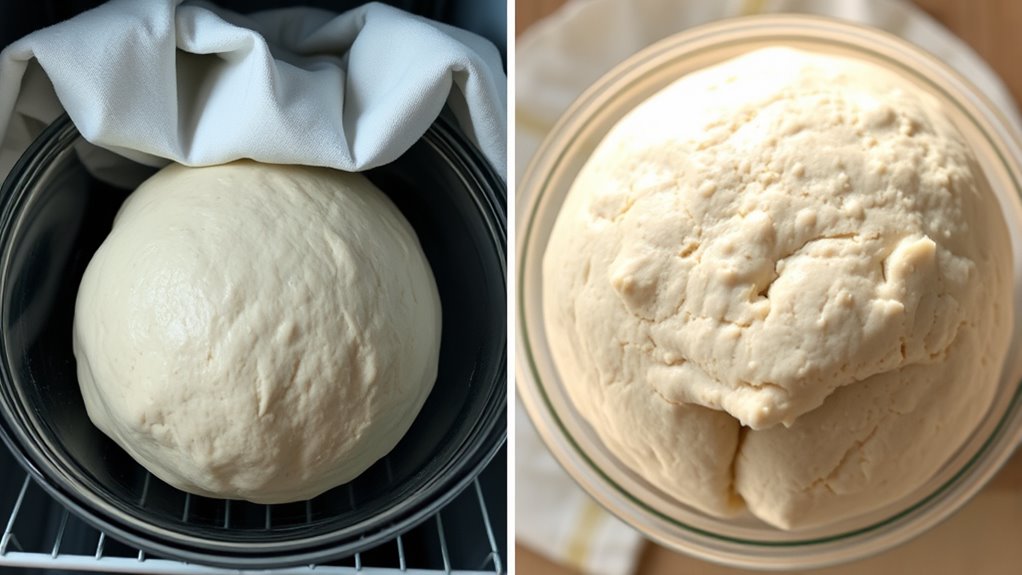
You’ll know your dough has fermented properly when you see bubbles forming on the surface, indicating active fermentation. It should also develop a pleasant, slightly tangy aroma that signals it’s ready. Additionally, the dough becomes more elastic and easier to stretch without tearing.
Visual Bubbles Formation
When your dough has fermented properly, you’ll notice small, bubbly pockets forming throughout the surface and interior. These visual bubbles are clear fermentation visuals that indicate active yeast and proper fermentation. Look for a network of tiny bubbles that give the dough a slightly puffed, airy appearance. You might also see larger bubbles near the surface, signaling good gas development. The dough should feel elastic and slightly sticky, with bubbles trapped inside. Proper fermentation results in a spongy texture and a lighter crust after baking. Keep an eye out for these signs, as they confirm your dough has reached its peak fermentation stage. Recognizing these fermentation visuals ensures you don’t over- or under-proof, leading to the best possible bake.
Aroma Development Clues
As the dough ferments, its aroma offers a reliable sensory cue that fermentation is complete. Aroma clues are among the most subtle yet telling scent indicators that your dough has reached the right stage. You’ll notice a pleasant, slightly tangy smell, which signals fermentation is active and progressing properly. If the scent is overly sour or off-putting, it might mean fermentation has gone too far or is contaminated. Conversely, a weak or absent aroma suggests it needs more time. Pay attention to these scent indicators, as they reveal how well your dough is developing flavor and texture. Trusting your nose is essential—you’ll get a sense for when it’s perfectly fermented, whether cold or room temperature.
Dough Elasticity Changes
One of the clearest signs that your dough has fermented properly is a noticeable change in its elasticity. As fermentation progresses, the gluten network develops, giving the dough a stretchier, more resilient feel. You’ll notice it becomes easier to shape without tearing, indicating ideal gluten development. Proper dough elasticity means the gluten strands have formed a strong, cohesive network capable of trapping gas.
- The dough springs back slowly when pressed with your finger
- It holds its shape without sagging or flattening
- It stretches without tearing easily
- It feels supple and slightly tacky but not sticky
These signs confirm that fermentation has advanced enough, and your dough has reached the right stage for baking.
Combining Cold and Room Temp Fermentation for Enhanced Flavor and Structure
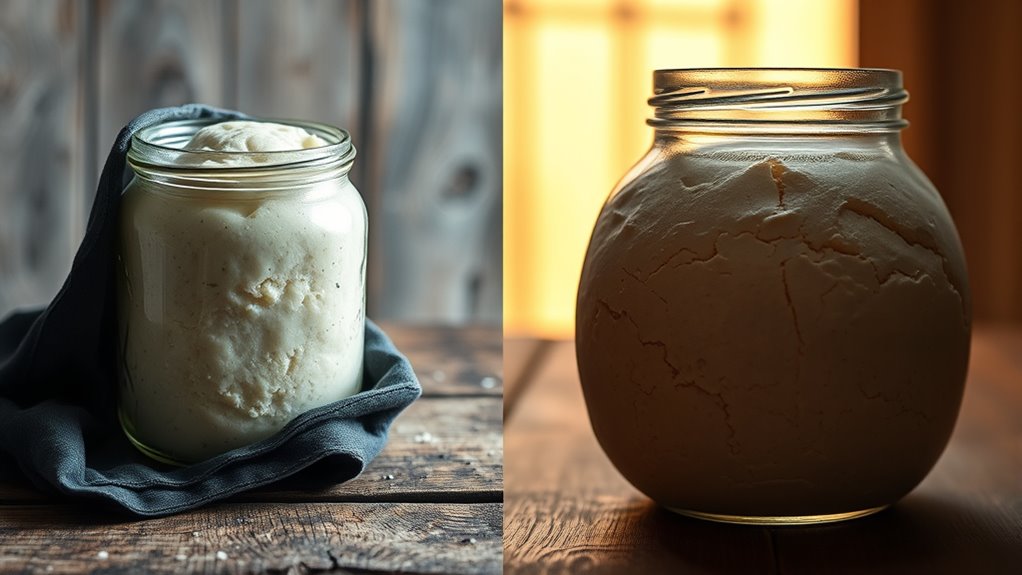
Combining cold and room temperature fermentation can considerably enhance both flavor and structure in your baked goods. This technique boosts flavor complexity by allowing enzymes to develop deeper, richer notes during extended cold fermentation, while finishing at room temperature helps activate gluten strength for better elasticity. Think of your dough as a layered experience:
| Cold Fermentation | Room Temperature Finish |
|---|---|
| Develops complex flavors | Strengthens gluten structure |
| Slows fermentation for depth | Adds a touch of airy lightness |
| Improves dough extensibility | Enhances oven spring |
| Retains moisture | Creates a balanced crumb |
Frequently Asked Questions
Can I Switch Between Cold and Room Temperature Fermentation Mid-Process?
Yes, you can switch between cold and room temperature fermentation mid-process, but be mindful of temperature fluctuations that can affect fermentation consistency. Changing temperatures too abruptly might cause uneven fermentation or unexpected flavor shifts. To maintain good results, make gradual adjustments and monitor the dough closely. This way, you keep fermentation consistent and prevent surprises, ensuring your baked goods turn out just how you want.
How Does Ambient Humidity Influence Fermentation at Different Temperatures?
Ambient humidity markedly impacts fermentation at different temperatures by affecting environmental moisture levels. High humidity increases moisture, which can slow fermentation and cause dough to become sticky. Conversely, low humidity dries out the dough, potentially halting fermentation or causing uneven proofing. When you ferment in humid environments, monitor dough closely, and adjust hydration or cover it properly. Keeping consistent humidity levels helps maintain steady fermentation regardless of temperature changes.
Are There Specific Dough Types Better Suited for Cold or Room Temp Fermentation?
Imagine your dough as a delicate orchestra waiting to perform; some types of dough thrive in the slow, gentle embrace of cold fermentation, like sourdough or artisan loaves, revealing complex flavors. Others prefer the lively tempo of room temperature fermentation, perfect for softer, quicker breads like naan or quickbreads. Your choice depends on the fermentation preferences you seek, shaping the final texture and taste of your baked masterpiece.
How Do I Adjust Fermentation Times if My Kitchen Temperature Fluctuates?
To adjust fermentation timing when your kitchen temperature fluctuates, focus on temperature control. If it gets warmer, your dough ferments faster, so you’ll need to shorten the fermentation time. Conversely, if it cools down, extend the fermentation to prevent overproofing. Keep a thermometer handy and monitor your dough closely. Consistent temperature control helps you maintain ideal fermentation timing, ensuring your bread develops the right flavor and texture every time.
Does Fermentation Temperature Affect Nutritional Content of the Final Product?
Yes, fermentation temperature affects the nutritional content of your final product. Warmer temperatures can boost enzyme activity, speeding up nutrient breakdown, but may also reduce nutritional preservation if it gets too hot. Cooler temperatures slow enzyme activity, helping preserve nutrients longer. By maintaining a consistent temperature, you guarantee ideal enzyme activity and better nutritional preservation, resulting in a healthier, more nutrient-rich final product.
Conclusion
So, next time you’re tempted to rush or overthink your dough, remember: the slow, cold fermentation often wins in flavor and texture—yet, here you are, reading about “rules” instead of just letting it happen naturally. Ironically, the best results come from patience and simplicity, not complex tricks. Sometimes, trusting the process—whether cold or room temp—is the real secret to perfect bread. After all, in baking as in life, less can be more.
